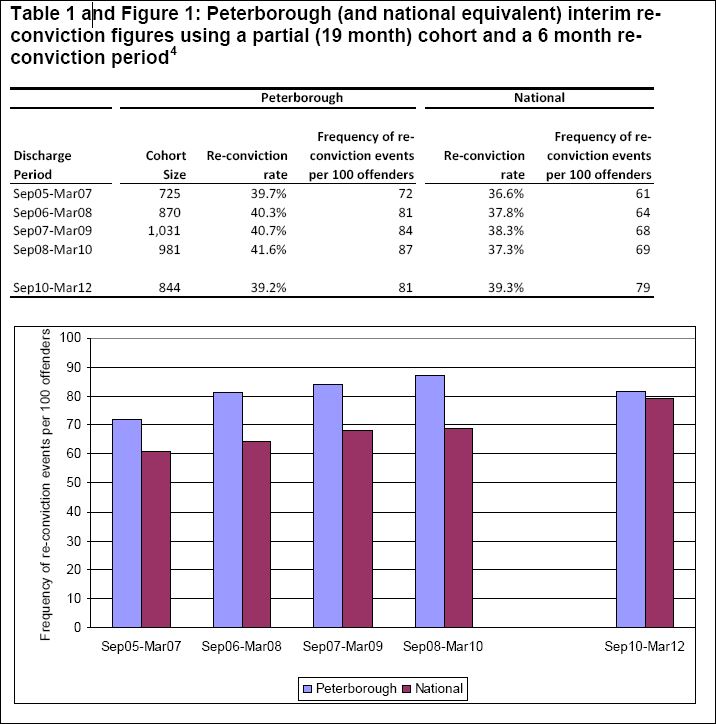Interim reconviction figures published
Yesterday the MoJ published interim reconviction figures from the reducing reoffending PbR pilots at Peterborough and Doncaster prisons.
The final results for just the first year’s cohort from these pilots won’t be available until 2014 but the MoJ have decided to publish these interim results because of the “high level of public interest” which has been created because the new reducing reoffending contracts will be let on a PbR basis.
These interim figures are based on offences committed in the six months following release from prison (with a further three month period which allows time for cases to go through the courts).
Peterborough
There were around 850 offenders in the Peterborough cohort which relates to offenders released between 9 September 2010 and 1 July 2012.
The reconviction measures are different for both pilots.
In Peterborough’s case, the outcome measure is the frequency of reconviction events.
The final reconviction figures will compare the performance of Peterborough with a control group of similar offenders released from other prisons.
The MoJ target, which triggers the outcome payment, is for the reoffending rate of Peterborough’s prisoners to be 10% less than the comparison cohort.
The chart below compares reoffending rates over time and against the national average.
For the first cohort of the PbR pilot, known as the ONE Project, there are an average of 81 reconviction events per 100 offenders in the six months following release.
This compares to an average of 87 reconviction events per 100 in the two years previous.
Nationally, the equivalent figures show a rise of 16% from 69 to 79 reconviction events per 100 offenders.
These results can be interpreted in one of two ways.
Optimists may argue that they are extremely encouraging – a 6% fall in the context of a 16% rise nationally is a strong performance.
Pessimists, however, could make the case that a reduction of 6% is not sufficient to trigger a success payment at a pilot site which had many more advantages – in terms of the amount of development time in particular – than will be available to the new rehabilitation providers.
Doncaster
The Doncaster cohort consists of approximately 750 offenders who were released from 1 October 2011 to 30 September 2012.
Unlike Peterborough, the Doncaster outcome measure is the proportion of offenders who commit one or more offences in the 12 months following release from prison and are convicted in the 18 month period following release (to allow time for the court process).
Success will be determined by comparison with the reconviction rate in the baseline year of 2009.
For those who know the jargon, this is basically a “binary” measure.
The chart below shows the six-month reconviction rate for the first half of the first year of the Doncaster cohort (those released between October 2011 and March 2012).
This rate was 41.1% compared to 41.6% for offenders released in October 2009 to March 2010.
This is a fall of 0.5%, compared to a national fall of 0.3%.
 Conclusion
Conclusion
To be honest, neither of these pilots have been running for a sufficiently long period of time for these results be treated with anything other than the utmost caution.
However, the interim figures are hardly earth-shattering and the pilots did have a number of advantages not available to the providers who win the new reducing reoffending contracts which will be awarded next Autumn.
The principal advantage, of course, is that the prisons and partnerships involved were actively seeking to pilot new approaches and had more time to plan their approach and were in a position, to an extent, to negotiate the terms of their PbR payment process.
My view is that these mediocre results make the MoJ’s recently published proposed payment mechanism seem even more unrealistic.
If we are really talking about transforming rehabilitation, then it will take several years for new approaches to bed in and be successful, yet the MoJ expects them to be delivering improvements in year one despite having to provide a service to many more offenders (50,000+ new short term prisoners) from within a reduced budget.









7 Responses
Publication of these very early and tentative findings has given cause to more overblown rhetoric on this not fully evaluated single project. To assert that “Early figures suggest that…” just does not cut it. There are few projects of which the same has not being said. Over-positive spin and rhetoric is put on whatever is said of this Peterborough single project.
David Hutchison, CEO of Social Finance, is quoted as stating that the success of the bond “will be determined by the summer of 2014”. That reads dangerously near to asserting ‘never mind the facts, I somehow know it will be found a success’.(It also inadvertently points up the lack of evaluation evidence for much of the current premature hype and rhetoric).
The real and present danger is that the unjustified spin and rhetoric is being spilled over by various interested parties into other core public services across the UK. The mention of Minister Grayling and SIBs is telling – this is an ideologically and politically-driven intent.
The hype seems at times to be omnipresent – just last week I came across another example in the ‘Economist’ journal:
http://www.economist.com/blogs/blighty/2013/05/prisoner-rehabilitation?fsrc=scn/ln_ec/the_peterborough_principles&goback=%2Egde_65951_member_245330002
Interesting figures. Part of my background is the employment world where I had the policy lead for training programmmes using payment by results almost 20 years ago.
There learned the risks of comparing a small pilot with national trends. Such comparisons are only meaningful if the population in the pilot (and the social and community context in which ex prisonners live) are very similar to that in the nation as a whole. I know both Doncaster and Peterborough and each have distinctive characteristics that lead me to question the validity of the comparisons being made. There are good techniques for overcoming these problems but there is no reference to them in the document.
interestngly the modest impact (notwithstanding the doubts about the methodology used) isvery similarto that in the recent figures about PbR in public health prigrammes on smoking and drug abuse – which have a somewhat similar client population given the interplay between substance abuse and offending.
I wuld be interested in any reactions, not least in relation to the implications for the Transforming Probation proposals.
So clearly this does not work and Failing Grayling is a fool to attempt to roll out such a flawed scheme onto the Probation Service.
Sign the Save Probation Petiton to stop him now!
Having just become aware of this programme via the BBC’s ‘Today’ programme, I feel a little embarrassed at having ‘come in late’. The ‘payment by results’ scheme seems to me to be so ill-conceived I am amazed it was ever given wheels. It is so patronising to the people (the offenders) concerned. If anyone is to be incentivised it should be these very people. One example of how this may be done: a portable employment subsidy making it more attractive for employers to take on former offenders, withdrawn if reoffending occurs. Scholarships for further education or vocational training could also be used.